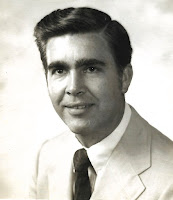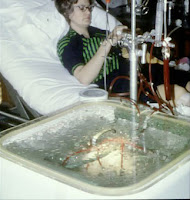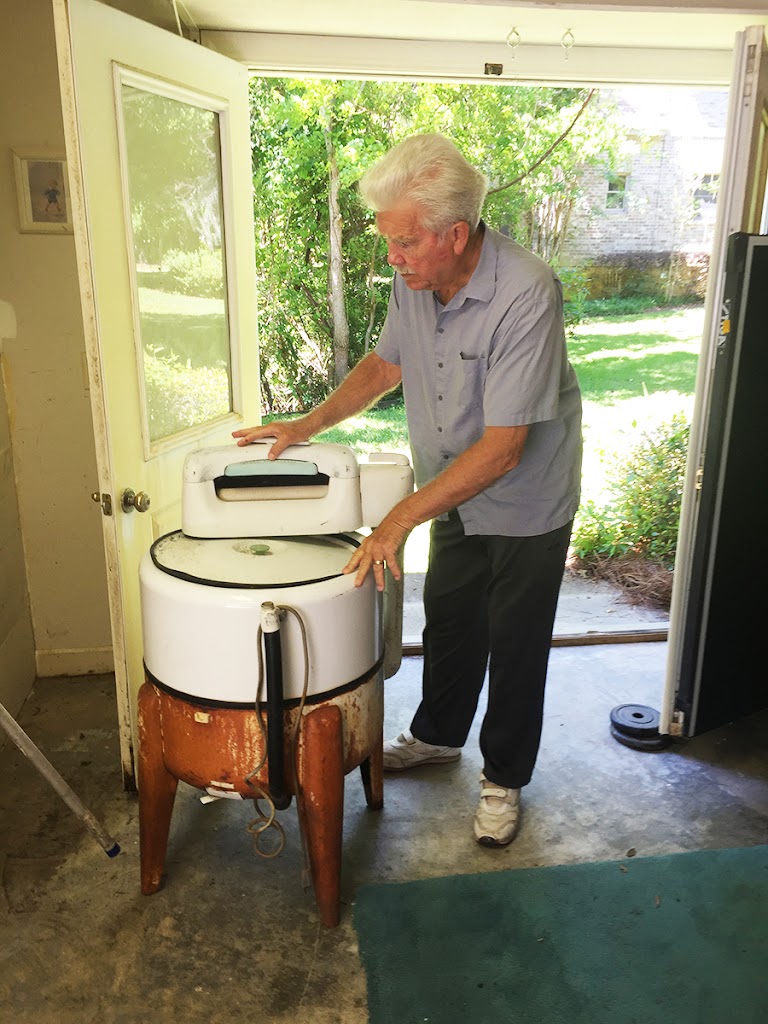Illustrated in 1960s Augusta, Georgia
An account at the coincidence of racial desegregation and the first hints of feasibility of long term dialysis and transplantation.
| George Van Giesen and Maytag washing machine (with permission of the author). |
George Van Giesen entered private practice in Augusta in 1963 from a two-year nephrology/metabolic fellowship in Dallas under Donald Seldin. There he encountered not only dialysis for acute renal failure, but also a Norwegian visiting professor Fredrik Kiil, who had just invented the flat plate dialyser, which came to be a mainstay of home haemodialysis.
Augusta did not have a haemodialysis machine, and peritoneal dialysis was attempted rarely. But soon Dr Van Giesen was sent patients with advanced renal disease. He prescribed the very low protein diets that had recently been described by Giordano and Giovannetti. But as their condition worsened he tried intermittent peritoneal dialysis (IPD), for example for 36h every three weeks. He recounts scouring medical journals for new ideas. Not found in them was his next trick, using motel rooms to do IPD when it couldn’t be done in hospital.
Experiments with jejunal loop dialysis, investigated by Kolff and others, followed. This had the huge advantage that it could be done at home, as sterility of fluids wasn’t an issue. But it didn’t clear many toxins.
At the same time, news was coming from a few academic centres that were beginning to attempt long-term dialysis, or transplantation, for highly selected patients.
 |
| George Van Giesen in the 1960s |
In Autumn 1965, the local hospital obtained a Travenol twin-coil dialysis machine for acute renal failure (as shown here), and in 1967 a small dialysis and transplant programme were commenced in the city. But to be eligible for dialysis, you had to be eligible for transplantation, which had strict age limits – at first age 45 or younger, and no other pathology. Some centres required a donor too. Many were not eligible.
In February 1969, Dr Van Giesen resigned his directorship of the dialysis programme, and set up a dialysis room in his own outpatient office. But machines were expensive. Inspired by Kolff’s Cleveland Clinic ‘Maytag’ programme, he adapted a washing machine from his own house, using disposable twin coil kidneys. His first patient built an improved machine himself and took it home, and later the service added two used Travenol machines. The intention was to train for home dialysis, as otherwise there was no capacity for new patients.
 |
| Maytag dialysis in Cleveland, courtesy Dr Yukihiko Nose |
Extending the lives of even a few required work, experimentation, and constant struggles for funding. Charitable funds were critical; for a while you could exchange 600,000 Betty Crocker coupons for a dialysis machine. Until in 1972 the US government made the remarkable decision to fund dialysis for all under the Medicare programme. The position of the hand-to-mouth enterprises of private physicians suddenly changed.
The spread of dialysis and transplantation has depended on many extraordinary local stories, but they are rarely told, most writing coming from academic centres. George Van Giesen’s remarkable memoir is presented as a series of memorable case histories.
Further reading
George Van Giesen, 2017. Prelude to Change. Ardent Writer Press. (available via Amazon US, Amazon UK).
Rettig RA, 1991. Origins of the Medicare Kidney Disease Entitlement: The Social Security Amendments of 1972.
On this blog:
Earliest dialysis for end stage renal disease
